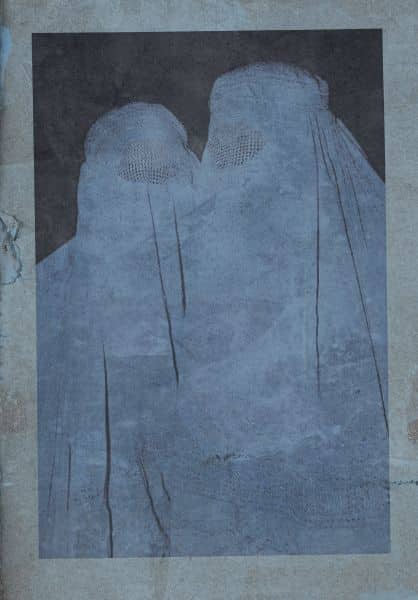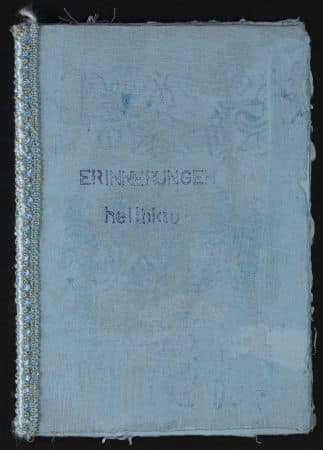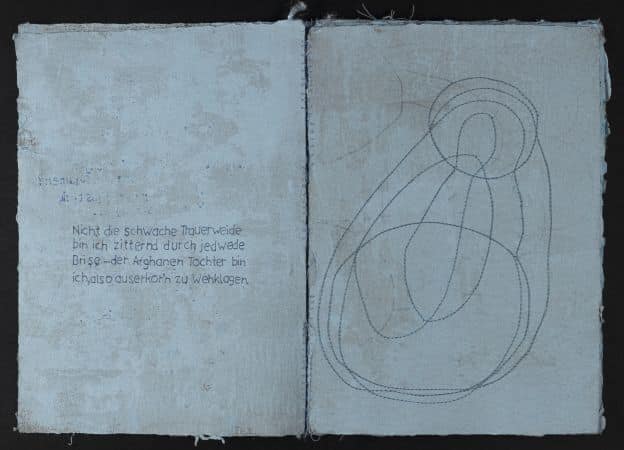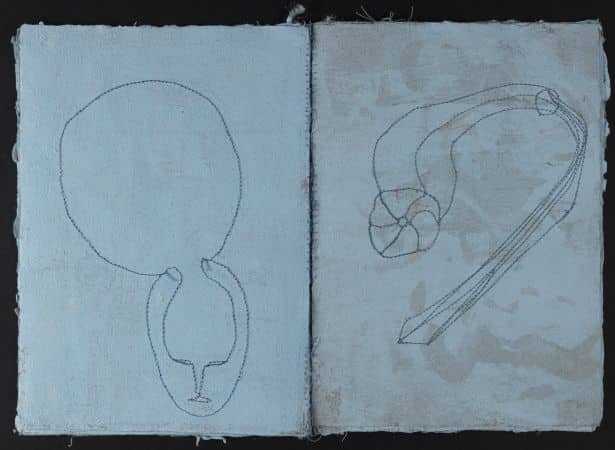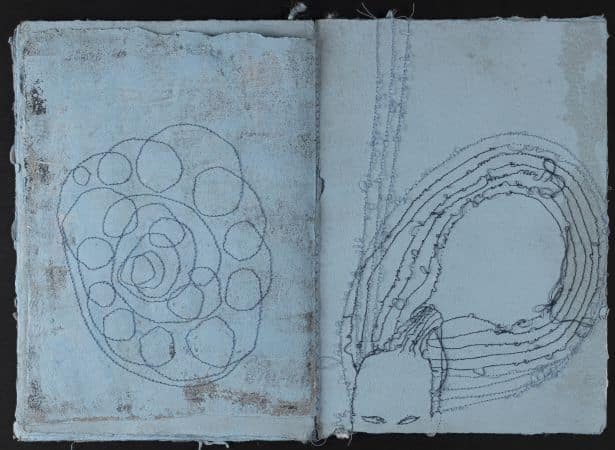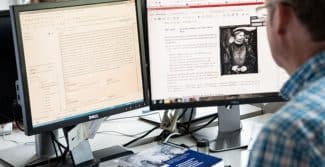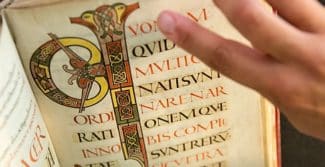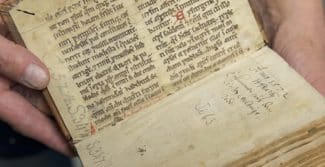7 September 2023
In 2005, Afghan poet and journalist Nadia Anjuman was beaten to death by her husband at the age of just 25. She had published her first volume of poetry that same year, which proved extremely popular in Afghanistan and Iran. Her renown was based on her classical style as well as on her book The Sewing Circles of Herat, about needlework groups that enabled women to disguise their studies.
Book and textile artist Carola Willbrand (b. 1952) commemorates Anjuman in her artist’s book Käfig, while also creating a symbol exemplifying female authorship. The artist’s book consists of three elements (fig. 1): a stole and two books.
The stole is made of black material to which floral-patterned white lace has been stitched, with two large pockets sewn into its ends. The inside of the stole contains white handwriting listing the names and dates of 28 female authors whose works were banned during the Nazi era. Two books, bearing the titles Erinnerungen hellblau (Memories Light Blue) and Erinnerungen grau (Memories Grey), are concealed within the pockets and completely enveloped by the stole. The books are made of sheets of paper that the artist has handcrafted from her own used clothing. They have been dyed, printed with monotypes and given a thread-sewn binding.
The landscape-format Erinnerungen grau (figs. 2, 3) gives the impression of leafing through a family album: it contains photographs that transport the viewer to the cosy parlour of a bygone age.
The subjects, who cannot be clearly identified, sit alone or in groups, surrounded by flowery wallpaper, white curtains and plush sofa cushions. The photographs are accompanied by a text written by the author. She describes a situation that could happen in many families – people sitting down, eating and drinking together, while a story keeps coming up that connects them all. In this case it is the tale of a man in a black coat who was frequently encountered on a busy street corner: ‘He opened the coat, spreading the inside of it out wide for all to see. The coat had many pockets there. There were books in these inside pockets. Books that were banned.’ The artist adds: ‘I can imagine that all those books in the pockets were works by banned authors, poets, writers, artists.’
The second book Erinnerungen hellblau (figs. 4,5,6,7) is dedicated to Anjuman. On the first page of this portrait-format book on light-blue paper there is the German translation of a ghazal – an Arabic form of poetry – by Anjuman in Willbrand’s handwriting. The following pages contain elements produced by a sewing machine as a nod to The Sewing Circles of Herat: lines of sewing form structures protruding from heads, functioning as associations with free-flowing thoughts and ideas. They conclude with the picture of two women in light-blue burkas. Creativity disappears behind the veil. On the last page, Willbrand commemorates Anjuman with a short biography of her life.
The three elements of the artist’s book Käfig are brought together by shrouding. But the stole not only shrouds the books concealed in the inside pockets, it also has a performative character. When someone places the stole around their shoulders, they become the man in the black coat, with the books concealed in his pockets bearing the names of banned authors on their back. But they also become one of the women who disappear beneath the black fabric (fig. 8).
In accordance with the title of her publication, Alle meine Künstlerinnen sind Superheldinnen (All My Women Artists Are Superheroines), Willbrand focuses her own work on female authorship and creativity – embarking on a search for female role models at the same time as she is creating them herself: her performances and artist’s books are explicitly dedicated to famous protagonists as well as those who have drifted into obscurity. In 2021, Käfig was the first book by Willbrand to be acquired by the Herzog August Bibliothek for its collection. The artist’s book is one of 20 acquisitions presented in the new publication Der rote Faden: Künstlerbücher der Herzog August Bibliothek 2000–2020 (A Common Thread: Artist’s Books in the Herzog August Bibliothek 2000–2020, 2023).
Der rote Faden presents texts and pictures from a selection of artist’s books acquired by the Herzog August Bibliothek between 2000 and 2020. Containing numerous illustrations and background information, the publication showcases artist’s books on very different themes that use a wide range of materials and techniques, emphasising that there are multiple strands to the HAB’s acquisitions policy.
Title image: Carola Willbrand, Käfig – Erinnerungen hellblau
The authors:
Sarah Janke and Alexandra Serjogin
